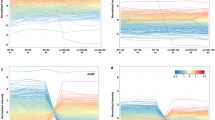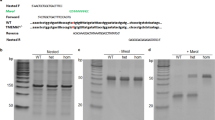Abstract
Congenital hydrocephalus is a major neurological disorder with high rates of morbidity and mortality; however, the underlying cellular and molecular mechanisms remain largely unknown. Reproducible animal models mirroring both embryonic and postnatal hydrocephalus are also limited. Here, we describe a new mouse model of congenital hydrocephalus through knockout of β-catenin in Nkx2.1-expressing regional neural progenitors. Progressive ventriculomegaly and an enlarged brain were consistently observed in knockout mice from embryonic day 12.5 through to adulthood. Transcriptome profiling revealed severe dysfunctions in progenitor maintenance in the ventricular zone and therefore in cilium biogenesis after β-catenin knockout. Histological analyses also revealed an aberrant neuronal layout in both the ventral and dorsal telencephalon in hydrocephalic mice at both embryonic and postnatal stages. Thus, knockout of β-catenin in regional neural progenitors leads to congenital hydrocephalus and provides a reproducible animal model for studying pathological changes and developing therapeutic interventions for this devastating disease.







Similar content being viewed by others
References
Walsh S, Donnan J, Morrissey A, Sikora L, Bowen S, Collins K. A systematic review of the risks factors associated with the onset and natural progression of hydrocephalus. Neurotoxicology 2017, 61: 33–45.
Arslan M, Aycan A, Gulsen I, Akyol ME, Kuyumcu F. Relationship between hydrocephalus etiology and ventriculoperitoneal shunt infection in children and review of literature. JPMA J Pak Med Assoc 2018, 68: 38–41.
Kahle KT, Kulkarni AV, Limbrick DD, Warf BC. Hydrocephalus in children. Lancet 2016, 387: 788–799.
Huo J, Qi Z, Chen S, Wang Q, Wu X, Zang D, et al. Neuroimage-based consciousness evaluation of patients with secondary doubtful hydrocephalus before and after lumbar drainage. Neurosci Bull 2020, 36: 985–996.
Davy BE, Robinson ML. Congenital hydrocephalus in hy3 mice is caused by a frameshift mutation in Hydin, a large novel gene. Hum Mol Genet 2003, 12: 1163–1170.
Feldner A, Adam MG, Tetzlaff F, Moll I, Komljenovic D, Sahm F, et al. Loss of Mpdz impairs ependymal cell integrity leading to perinatal-onset hydrocephalus in mice. EMBO Mol Med 2017, 9: 890–905.
Galbreath E, Kim SJ, Park K, Brenner M, Messing A. Overexpression of TGF-beta 1 in the central nervous system of transgenic mice results in hydrocephalus. J Neuropathol Exp Neurol 1995, 54: 339–349.
Ibañez-Tallon I, Gorokhova S, Heintz N. Loss of function of axonemal dynein Mdnah5 causes primary ciliary dyskinesia and hydrocephalus. Hum Mol Genet 2002, 11: 715–721.
Jiménez AJ, Tomé M, Páez P, Wagner C, Rodríguez S, Fernández-Llebrez P, et al. A programmed ependymal denudation precedes congenital hydrocephalus in the hyh mutant mouse. J Neuropathol Exp Neurol 2001, 60: 1105–1119.
Páez P, Bátiz LF, Roales-Buján R, Rodríguez-Pérez LM, Rodríguez S, Jiménez AJ, et al. Patterned neuropathologic events occurring in hyh congenital hydrocephalic mutant mice. J Neuropathol Exp Neurol 2007, 66: 1082–1092.
Sapiro R, Kostetskii I, Olds-Clarke P, Gerton GL, Radice GL, Strauss JF III. Male infertility, impaired sperm motility, and hydrocephalus in mice deficient in sperm-associated antigen 6. Mol Cell Biol 2002, 22: 6298–6305.
Boillat CA, Jones HC, Kaiser GL. Aqueduct Stenosis in hydrocephalus: Ultrastructural investigation in neonatal H-Tx rat brain. Eur J Pediatr Surg 1999, 9: 44–46.
Jones HC, Bucknall RM. Inherited prenatal hydrocephalus in the H-Tx rat: A morphological study. Neuropathol Appl Neurobiol 1988, 14: 263–274.
Jones HC, Lopman BA, Jones TW, Carter BJ, Depelteau JS, Morel L. The expression of inherited hydrocephalus in H-Tx rats. Child’s Nerv Syst 2000, 16: 578–584.
Leliefeld PH, Gooskens RHJM, Tulleken CAF, Regli L, Uiterwaal CSPM, Han KS, et al. Noninvasive detection of the distinction between progressive and compensated hydrocephalus in infants: Is it possible? J Neurosurg Pediatr 2010, 5: 562–568.
Moritake K, Nagai H, Nagasako N, Yamasaki M, Oi S, Hata T. Diagnosis of congenital hydrocephalus and delivery of its patients in Japan. Brain Dev 2008, 30: 381–386.
Bátiz LF, De Blas GA, Michaut MA, Ramírez AR, Rodríguez F, Ratto MH, et al. Sperm from hyh mice carrying a point mutation in alphaSNAP have a defect in acrosome reaction. PLoS One 2009, 4: e4963.
Dafinger C, Rinschen MM, Borgal L, Ehrenberg C, Basten SG, Franke M, et al. Targeted deletion of the AAA-ATPase Ruvbl1 in mice disrupts ciliary integrity and causes renal disease and hydrocephalus. Exp Mol Med 2018, 50: 1–17.
de Wit OA, den Dunnen WF, Sollie KM, Muñoz RI, Meiners LC, Brouwer OF, et al. Pathogenesis of cerebral malformations in human fetuses with meningomyelocele. Cerebrospinal Fluid Res 2008, 5: 4.
Sival DA, Guerra M, den Dunnen WF, Bátiz LF, Alvial G, Castañeyra-Perdomo A, et al. Neuroependymal denudation is in progress in full-term human foetal spina bifida aperta. Brain Pathol 2011, 21: 163–179.
Domínguez-Pinos MD, Páez P, Jiménez AJ, Weil B, Arráez MA, Pérez-Fígares JM, et al. Ependymal denudation and alterations of the subventricular zone occur in human fetuses with a moderate communicating hydrocephalus. J Neuropathol Exp Neurol 2005, 64: 595–604.
Shinozuka T, Takada R, Yoshida S, Yonemura S, Takada S. Wnt produced by stretched roof-plate cells is required for the promotion of cell proliferation around the central canal of the spinal cord. Development 2019, 146. doi:https://doi.org/10.1242/dev.159343.
Xing L, Anbarchian T, Tsai JM, Plant GW, Nusse R. Wnt/β-catenin signaling regulates ependymal cell development and adult homeostasis. Proc Natl Acad Sci U S A 2018, 115: E5954–E5962.
Takagishi M, Sawada M, Ohata S, Asai NY, Enomoto A, Takahashi K, et al. Daple coordinates planar polarized microtubule dynamics in ependymal cells and contributes to hydrocephalus. Cell Rep 2017, 20: 960–972.
Ohata S, Nakatani J, Herranz-Pérez V, Cheng J, Belinson H, Inubushi T, et al. Loss of Dishevelleds disrupts planar polarity in ependymal motile Cilia and results in hydrocephalus. Neuron 2014, 83: 558–571.
Cai YQ, Zhang QQ, Wang CM, Zhang Y, Ma T, Zhou X, et al. Nuclear receptor COUP-TFII-expressing neocortical interneurons are derived from the medial and lateral/caudal ganglionic eminence and define specific subsets of mature interneurons. J Comp Neurol 2013, 521: 479–497.
Xu Q, Tam M, Anderson SA. Fate mapping Nkx2.1-lineage cells in the mouse telencephalon. J Comp Neurol 2008, 506: 16–29.
Srinivas S, Watanabe T, Lin CS, William CM, Tanabe Y, Jessell TM, et al. Cre reporter strains produced by targeted insertion of EYFP and ECFP into the ROSA26 locus. BMC Dev Biol 2001, 1: 4.
Brault V, Moore R, Kutsch S, Ishibashi M, Rowitch DH, McMahon AP, et al. Inactivation of the (β)-catenin gene by Wnt1-Cre-mediated deletion results in dramatic brain malformation and failure of craniofacial development. Development 2001, 128: 1253–1264.
Delgado RN, Lim DA. Embryonic Nkx2.1-expressing neural precursor cells contribute to the regional heterogeneity of adult V-SVZ neural stem cells. Dev Biol 2015, 407: 265–274.
Gulacsi AA, Anderson SA. Beta-catenin-mediated Wnt signaling regulates neurogenesis in the ventral telencephalon. Nat Neurosci 2008, 11: 1383–1391.
Zechel S, Zajac P, Lönnerberg P, Ibáñez CF, Linnarsson S. Topographical transcriptome mapping of the mouse medial ganglionic eminence by spatially resolved RNA-seq. Genome Biol 2014, 15: 486.
Ma L, Wang Y, Hui Y, Du Y, Chen Z, Feng H, et al. WNT/NOTCH pathway is essential for the maintenance and expansion of human MGE progenitors. Stem Cell Reports 2019, 12: 934–949.
Duncan RN, Xie Y, McPherson AD, Taibi AV, Bonkowsky JL, Douglass AD, et al. Hypothalamic radial Glia function as self-renewing neural progenitors in the absence of Wnt/β-catenin signaling. Development 2016, 143: 45–53.
Saito T, Hanai S, Takashima S, Nakagawa E, Okazaki S, Inoue T, et al. Neocortical layer formation of human developing brains and lissencephalies: Consideration of layer-specific marker expression. Cereb Cortex 2011, 21: 588–596.
Cubelos Beatriz, Briz Carlos G., Maria EstebanOrtega Gemma, Nieto Marta. Cux1 and Cux2 selectively target basal and apical dendritic compartments of layer II-III cortical neurons. Dev Neurobiol 2015, 75: 163–172.
Wang CM, You Y, Qi DS, Zhou X, Wang L, Wei S, et al. Human and monkey striatal interneurons are derived from the medial ganglionic eminence but not from the adult subventricular zone. J Neurosci 2014, 34: 10906–10923.
Fragkouli A, van Wijk NV, Lopes R, Kessaris N, Pachnis V. LIM homeodomain transcription factor-dependent specification of bipotential MGE progenitors into cholinergic and GABAergic striatal interneurons. Development 2009, 136: 3841–3851.
Kepecs A, Fishell G. Interneuron cell types are fit to function. Nature 2014, 505: 318–326.
Marín O. Cellular and molecular mechanisms controlling the migration of neocortical interneurons. Eur J Neurosci 2013, 38: 2019–2029.
Cuesta S, Funes A, Pacchioni AM. Social isolation in male rats during adolescence inhibits the wnt/β-catenin pathway in the prefrontal cortex and enhances anxiety and cocaine-induced plasticity in adulthood. Neurosci Bull 2020, 36: 611–624.
Zheng H, Yu WM, Waclaw RR, Kontaridis MI, Neel BG, Qu CK. Gain-of-function mutations in the gene encoding the tyrosine phosphatase SHP2 induce hydrocephalus in a catalytically dependent manner. Sci Signal 2018, 11: eaao1591. doi:https://doi.org/10.1126/scisignal.aao1591.
Chi L, Fan B, Feng D, Chen Z, Liu Z, Hui Y, et al. The dorsoventral patterning of human forebrain follows an activation/transformation model. Cereb Cortex 2017, 27: 2941–2954.
Treat AC, Wheeler DS, Stolz DB, Tsang M, Friedman PA, Romero G. The PDZ protein Na+/H+ exchanger regulatory factor-1 (NHERF1) regulates planar cell polarity and motile Cilia organization. PLoS One 2016, 11: e0153144.
McAllister JP. Pathophysiology of congenital and neonatal hydrocephalus. Semin Fetal Neonatal Med 2012, 17: 285–294.
Vio K, Rodríguez S, Yulis CR, Oliver C, Rodríguez EM. The subcommissural organ of the rat secretes Reissner’s fiber glycoproteins and CSF-soluble proteins reaching the internal and external CSF compartments. Cerebrospinal Fluid Res 2008, 5: 3.
Rodríguez EM, Guerra MM. Neural stem cells and fetal-onset hydrocephalus. Pediatr Neurosurg 2017, 52: 446–461.
Acknowledgements
This work was supported by grants from the National Key Research and Development Program of China (2018YFA0108000 and 2019YFA0110300), the National Natural Science Foundation of China (8205020, 32000689, 31400934, 31771132, 31872760, 31801204, and 31800858), the Science and Technology Commission of Shanghai Municipality (19JC1415100 and 21140902300), the Shanghai Municipal Education Commission (C120114), China Postdoctoral Science Foundation (2017M621526), the Fundamental Research Funds for the Central Universities, and the Major Program of Development Fund for Shanghai Zhangjiang National Innovation Demonstration Zone (Stem Cell Strategic Biobank and Clinical Translation Platform of Stem Cell Technology, ZJ2018-ZD-004).
Author information
Authors and Affiliations
Corresponding authors
Ethics declarations
Conflict of interest
The authors declare no conflict of interest.
Supplementary Information
Below is the link to the electronic supplementary material.
Rights and permissions
About this article
Cite this article
Ma, L., Du, Y., Xu, X. et al. β-Catenin Deletion in Regional Neural Progenitors Leads to Congenital Hydrocephalus in Mice. Neurosci. Bull. 38, 81–94 (2022). https://doi.org/10.1007/s12264-021-00763-z
Received:
Accepted:
Published:
Issue Date:
DOI: https://doi.org/10.1007/s12264-021-00763-z




